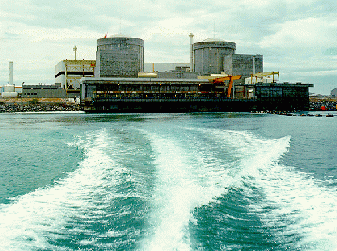
|
The
Virtual Nuclear Tourist !!! Nuclear Power Plants Around the World
Nuclear Power Plants - South
Africa |
ESKOM, the South African electric
utility, operates a 2 unit site at Koeberg Nuclear Power Station near
Capetown. Each unit is a 3 loop Framatome Pressurized Water Reactor rated
at 920 MWe. The trubine-generator sets were provided by Alsthom. The picture below shows
the 2 units, each with a metal/concrete containment. A breakwater can be seen on the
seaward side of the plant. The condenser on the secondary side is cooled by seawater. Unit
1 started up in 1984 and Unit 2 in 1985.

Courtesy ESKOM
The Framatome units are the French version of the Westinghouse PWR. Each of the 3
cooling loops is connected to the reactor and a reactor coolant pump and a steam
generator. A pressurizer is connected to one of the 3 loops.
A number of simplified diagrams illustrate the the design of this pressurized water
reactor plant (courtesy Westinghouse). The
following are colored perspective and arrangement drawings of
The flow paths are illustrated by a colored graphic flow diagram
and a black and white line
drawing. The following describes the flow path and the linked drawings illustrate, in
detail, the composition and major parts of the components. The temperatures stated are
representative of many PWRs and may vary for specific plants.
- Reactor - this diagram
shows how the reactor is constructed with its major components. Water at 530F enters the
reactor from the nozzles at about mid-height. The water flows downward on the outside of
the core barrel to the bottom of the reactor. Then the flow turns upward past the fuel assemblies, removing heat
from the assemblies and increasing in temperature to 590-600F. After leaving the core
area, the water mixes in the upper plenum and leaves the reactor through nozzles. Flow
then goes to the
- Steam Generator where
the radioactive Reactor Cooling System water enters at the bottom, flows through small
inverted U-tubes. That water loses its heat as it passes through the tube being cooled by
the non-radioactive water outside the tube. Non-radioactive feedwater enters through the
nozzles at the mid-height of the steam generator at a temperature of about 425F. The water
flows downward outside a wrapper sheet to the area just above the tubesheet where the
water turns and flows upward past the U-tubes. The water increases in temperature and
turns to steam. A moist steam at about 510-547F with pressure of 720-1005 pounds per
square inch is produced. The moist steam travels upward to steam separators (chevron
separators and swirl vanes) which allow 99.75% purity steam to pass of the steam generator
and the remaining water is directed back to the lower part of the steam generator. The
reactor cooling system water enters the steam generator at ~590F and leaves at ~ 530F.
That water then flows to the
- Reactor Coolant Pump which
pumps the water back to the reactor.
- Pressurizer is used to
control the pressure in the reactor cooling system so that boiling does not occur in the
reactor. The pressurizer also is used to act as a surge tank for the system taking up the
level variations in the system. Heaters are installed at the bottom of the pressurizer for
heating the water to 652F and 2250 pounds per square inch. Automated pressure control
valves (called power operated relief valves) and safety valves, connected to the top of
the pressurizer, can open to control and maintain pressure.
- Secondary Systems line
drawings identifying major sub-components in the non-radioactive part of the system where
steam flows to the turbine, condenses in the condenser, then is pumped back to the steam
generator first by condensate pumps, then by feedwater pumps. The feedwater heaters
improve the efficiency of the cycle by recovering and reusing energy that would otherwise
be lost. By doing so efficiency of the cycle is raised to 33%.

Courtesy ESKOM
The photo above shows the plant view from the intake basin. In the foreground is the
screenhouse which conditions the seawater before it is pumped by large circulating water
pumps through the condenser and back to the sea.
Other relevant South Africa links:
| Virtual
Nuclear Tourist | Table
of Contents | Welcome
| FAQ | Glossary NRC | E-Mail ? |
Copyright © 1996-2004. Joseph Gonyeau. All rights reserved. Revised:
August 23, 1999.

